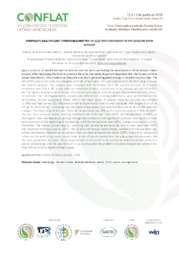Immediate analysis and thermogravimetric of açaí seeds produced in the Amazon River Estuary.
Immediate analysis and thermogravimetric of açaí seeds produced in the Amazon River Estuary.
Author(s): RIBEIRO, E. A. dos S.; PASTANA, D. N. B.; BUFALINO, L.; LIRA-GUEDES, A. C.; GUEDES, M. C.
Summary: Açaí is a source of wealth for riverine families and has been promoting the development of the Amazon River estuary. After depulping the fruits to produce the wine, the seeds of açaí are deposited near the houses without proper destination. This problem can become a solution, generating green energy in isolated communities. The aim of this study is estimate the energetic potential of açaí seeds. This work was done in Ilha das Cinzas, Gurupá-PA, Eastern Amazon. The samples were collected with 10 families (n = 40), packed and sent to a forced ventilation oven 105 ± 2ºC. It was done an immediate analysis, in duplicate, in accordance with ASTM D1762-84. The highest heating value (HHV) was determined with volatile material values, fixed carbon and ash content. In addition, the thermogravimetric analysis and differential scanning calorimetry were performed on the PerkinElmer TG-DSC equipment, model DSC-7. The mean values of volatile materials (74.57%), ash content (1.70%) and fixed carbon (23.74%) were similar to those found in the oil seed literature. HHV ranged from 19.91 MJ kg-1 to 20.10 MJ kg-1, indicating that the waste of açaí seeds is an excellent resource to be transformed into a biogas. The mean pulp content was 21% and the açaí seeds was 79%, with a moisture content of 30%. At 200oC, the mass loss increases rapidly, reaching maximum rate of 5% min-1 near 300oC. At a temperature of 500°C, all the organic mass was degraded, passing through the combustion and gasification process, leaving only a small amount of ash. At the beginning of the heating, until the temperature near 100ºC, energy consumption occurs. Thereafter, the release process begins, increasing with increasing temperature, with a small peak near 320oC and maximum enthalpy close to 500oC. The variation of the açaí seed enthalpy, enables it to the energetic use, whose optimization depends on equipment that can keep temperatures above 300ºC. Seasonality production influences the yield of açaí seed considerably. In the off-season production, the pulp proportion decreases and the seed proportion increases. These experimental results confirm the qualitative potential of açaí seeds as a source of bioenergy, and the possibility of its use to help solve the problem of isolated Amazonian communities that still live without regular energy supply.
Publication year: 2018
Types of publication: Abstract in annals or event proceedings
Unit: Embrapa Amapá
Keywords: Agricultural wastes, Açaí, Bioenergia, Bioenergy, Euterpe Oleracea, Resíduo
Observation
Some of Embrapa's publications are published as ePub files. To read them, use or download one of the following free software options to your computer or mobile device. Android: Google Play Books; IOS: iBooks; Windows and Linux: Calibre.
Access other publications
Access the Agricultural Research Database (BDPA) to consult Embrapa's full library collection and records.
Visit Embrapa Bookstore to purchase books and other publications sold by Embrapa.

